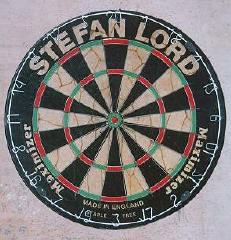
An early version of Darts called Puff and Dart, used a blowpipe to fire a dart at the target. In 1844, during a game of Puff and Dart at a London pub, a player made the unfortunate mistake of sucking rather than blowing. The dart disappeared into his digestive system whereupon the poor chap died a few days later.
 |
Early forms of Darts started to grown in popularity in the 19th Century but it didn't become a serious pub game until the 20th century when it was known as Dart and Target according to 'Lawful Games on Licensed Premises', 1904. Dart and Target was played on a board of numbered coloured circles, on which doubles and trebles did not feature, the highest score being the bullseye and lowest at the edge. Brewers started to organise leagues from around 1925. It received a big boost in 1937,when the King and Queen toured a social club in Slough, Berkshire and casually threw darts at a dartboard. The Sunday Chronicle reported that "the Queen has made the women of Britain darts-conscious." According to the Mass-Observation researchers who studied pub life in Bolton during the 1930's the number of Dart playing pubs trebled over the next two years where it seemed to replace Quoits as the game of choice. Like other games, however, Darts suffered from laws prohibiting it in places such as Liverpool and Glasgow. |
 |
Although the standard or trebles or "London" board pictured is the primary darts board in use today, many different designs have existed over the years and non-London variants are still around. Still known to be used are the Yorkshire board, the Lancashire or Manchester board, the Staffordshire Board and East End Darts is also still popular being played on a boards with segments scoring multiples of five. The London board's segmented numbering scheme is inherited from the old Yorkshire, Burton, Irish and Lincoln boards which have a similar arrangement. The origin of the strange numbering scheme that is common to many of the boards is lost in history but it appears that the distinctive arrangement of the numbers was invented sometime in the late 19th century, probably in the North of England. It isn't known why the numbers are placed as they are but it it is clear that some effort has been taken to ensure that consecutive numbers are mostly placed well away from each other.
The only picture that exists of any dartboard prior to 1920 is a picture of the Grimsby board from around 1890. The numbers go from 1 to 28, there's a single bullseye and no trebles. The board is big and black but the numbering follows the same rather pattern of high numbers adjacent to low numbers around the edge.
Today, Darts is played by 6 million people regularly and features on Satellite TV.
If you want to submit a pub to this list, please feel free to send a request by email.
The Tempest Arms, Elsack, near Skipton, North Yorkshire
The Village Inn, Hawnby, Yorkshire
The Thorold Arms, Harmston, Yorkshire
The Old House At Home, Withington, Greater Manchester
The Crown Inn, Yoxall, Staffordshire.
The Resolute, High Street, Poplar, London
The Old Star, Wapping, London
Duke of Wellington, Devas Street, Bow, London
Patrick Chaplin, Darts
Historian
British Darts Organisation
Darts World Magazine
All About Darts - from the USA.
![]()
| The Online Guide to Traditional Games Home | Copyright ķ 1997-2001 by AGames. |